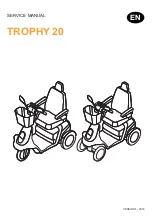
20
2. Clean battery terminals and the inside of cable clamps using a post and clamp
cleaner. Clean terminals will have a bright metallic shine. This should be done
as needed.
3. Reconnect the clamps to the terminals and thinly coat them with petroleum
jelly (Vaseline) to prevent corrosion.
•
WARNING! Before you disconnect any battery cable from any terminal on
the battery, always remove the power by disconnecting the main battery
cable from the controller.
Checking the terminals and nuts:
The connection of the batteries should be kept
in good condition. Check the battery cable terminals and nuts weekly in order to
prevent sparking or damage to terminals. A damaged battery cable should be re-
placed immediately.
Battery compartment:
Do not place any objects on the battery and do not con-
nect the positive pole to the negative pole. This may cause a short circuit or danger-
ous sparking. This can cause damage to the battery or injury to the user.
Recharging
1. Regardless of how long you have used the vehicle, the battery should be re-
charged fully on the same day. Any delay on the re-charging will reduce the life
of the battery.
Note:
The lead-acid battery does not develop a memory, so it
need not be fully discharged before recharging.
2. If the vehicle is going to be kept unused for a long time, the battery should be
fully recharged first. After that, the battery should be fully recharged every 2
weeks.
3. When driving, the driver should be aware of the drop level of the battery power
from the battery power meter. The driver should estimate the distance needed
to be taken, and recharge the battery at a proper time to ensure that the vehi-
cle can get back to the charging location in time for recharging.
•
WARNING! Make sure the battery is recharged before the battery power
meter shows 20% is left. An over-discharged battery will have a very short
service life.
•
WARNING! During recharging, the vehicle should be parked in a well-ven-
tilated area with filling caps tightly secured. Keep far away from any flame
and sparks to avoid any explosion or fire that could cause physical injury
or damage to property.
































